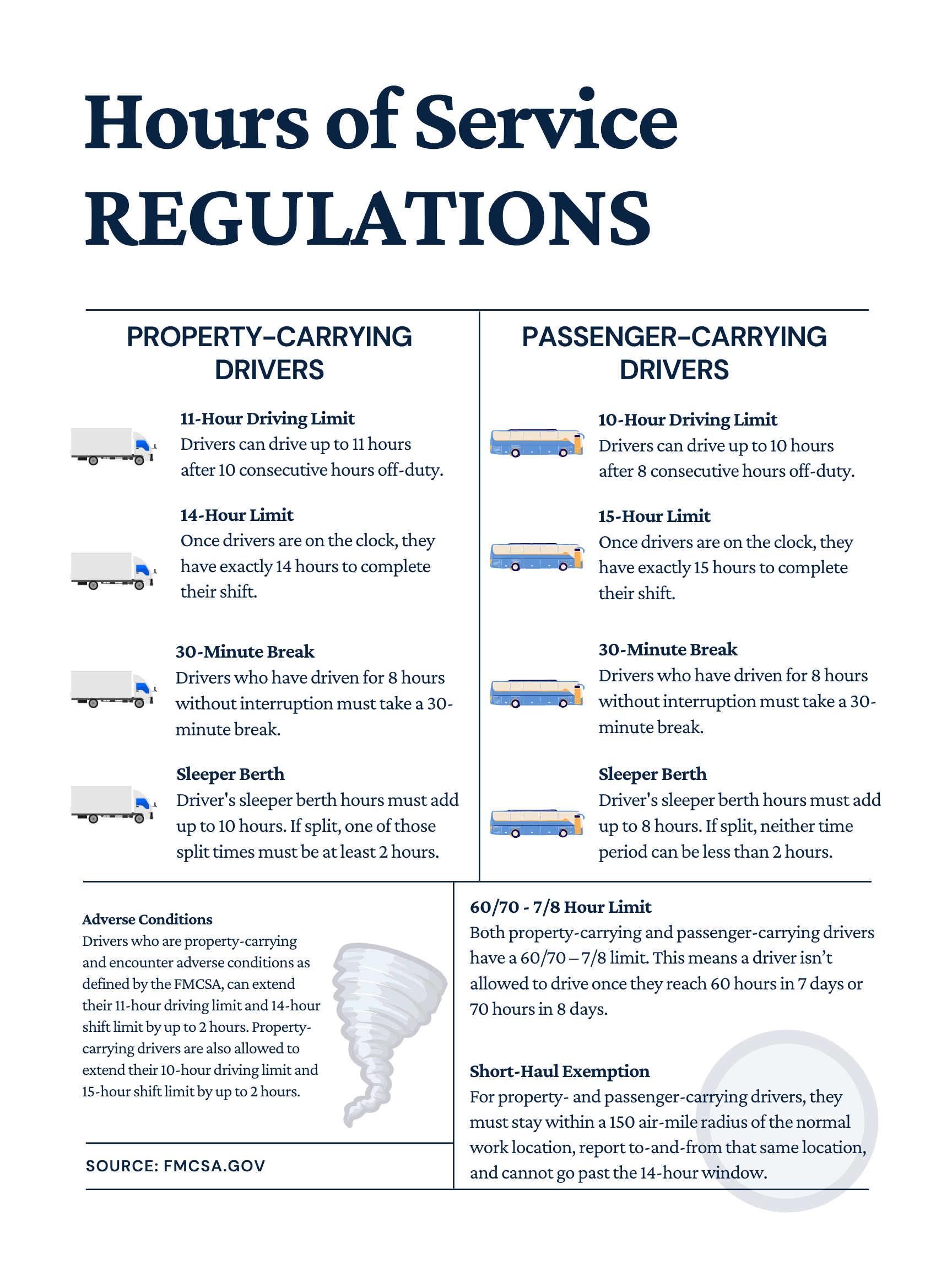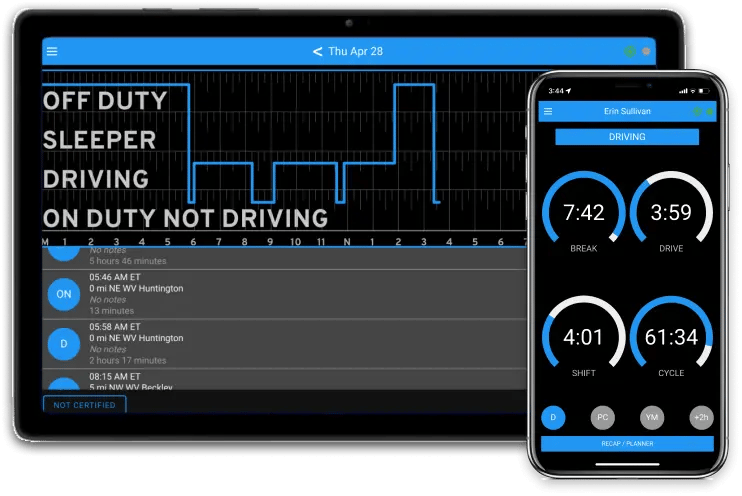Many drivers are unsure about the ins and outs of the hours of service rules. There are HOS rules for passenger carrying vehicles, property carrying vehicles, local drivers and all of the rules are a little different from each other.
The Hours of service (HOS) Final Rule was updated on June 1, 2020, the FMCSA revised four provisions of the hours of service regulations to provide greater flexibility for drivers without adversely affecting safety. Motor carriers are required to comply with the new HOS regulations.
The hours of service rules are one of 7 FMCSA's CSA BASICs that are put in place to monitor safety on public roads as a motor carrier. The hours of service BASIC accounts for the driver's ability to maintain their working hours to prevent overworking and driver fatigue.
We will go over all of the different areas of hours of service final rule so that you will know which rules apply to you.
Who has to comply with hours of service rules?
Drivers of a commercial motor vehicle (CMV) that is used as part of a business and is involved in interstate commerce must comply with HOS laws. If you fit any of these descriptions, you will need to follow the HOS rules:
- Your vehicle weighs 10,001 pounds or more
- Your vehicle has a gross vehicle weight rating (GVWR) or gross combination weight rating of 10,001 pounds or more
- Your vehicle is used to transport 16 or more passengers including the driver for compensation
- Your vehicle is designed to transport 9 or more passengers including the driver for compensation
- Your vehicle transports hazardous materials in a quantity that requires placards
Property Carrying Drivers and HOS
For drivers who haul property they will follow 1 of 2 cycle rules according to the federal mandate. These cycle rules are the guidelines for how many hours a driver can work per week and manage a decent level of safety while avoiding fatigue. This is mostly depended on whether the carrier that they are working for operates 7 days per week or not.
60 hour/7 day cycles.
This is the least common of the 2 work cycles that drivers can follow. This cycle set if used by drivers whose carrier does not operate 7 days per week.
A 60 hour/7 day cycle means that a driver can only work 60 hours in a rolling 7- day period. If the driver hits their 60-hour limit inside of the rolling 7-day window, then they can no longer drive and must wait for previous work hours to fall off the tail end at the start of a new day or take a 34-hour reset to start a new cycle.
70 hour/8 day cycles
70 hour/8 day cycles are similar to 60 hour/7 day cycles except that the driver has a longer window to perform on duty work. In this cycle the driver has an 8- day rolling window where they can work up to 70 hours. If the driver meets the 70-hour limit inside the 8-day window, then they can no longer drive and will need to wait for hours to fall off the tail end of their window at the start of a new day or perform a 34 hour off duty break to reset their cycle.
Note: It is possible for a driver to work every day without ever having to do a 34-hour reset to start a new cycle. Drivers can keep "recap table" of their on- duty hours and any time at the end of their 7-day window will fall off of their cycle and they can use that time at the start of a new day
11-hour driving limit
Property carrying drivers have an 11-hour driving limit that they can drive in a given 14 hour driving window or workday. Once the driver has reached their 11- hour limit they cannot drive again until they take a 10 hour rest off duty.
14-hour driving window
Property carrying drivers have a 14-hour window that they must work inside of before taking a 10-hour rest. This 14-hour window starts as soon as the driver performs any work-related task for the day. If a driver is on the clock and getting paid, this time must be logged as on duty not driving.
All working hours must be logged in the drivers log book even if the work they are performing is for a different employer. A driver can continue to work past their 14-hour window but they are not allowed to drive until they have had a 10- hour rest.
30-minute driving break
Property carrying drivers must take a 30-minute break after 8 consecutive hours of driving. The break must be a continuous 30 minutes uninterrupted. Under the revised HOS rules the 30-minute break can be any non-driving status (i.e. on-duty not driving, off-duty, sleeper berth or any combination of the 3)
Adverse conditions
In the case that a driver encounters adverse driving conditions that they could not have planned for that would keep them from making it to their planned destination they extend their driving window. Property carrying drivers can extend their 14-hour drive window and their 11-hour drive time up to 2 hours under certain conditions.
Sleeper berth split provision
Property carrying drivers may split their required 10-hour off-duty period, as long as one off-duty period (whether in or out of the sleeper berth) is at least 2 hours long and the other involves at least 7 consecutive hours spent in the sleeper berth split. All sleeper berth split pairings must add up to at least 10 hours. When used together, neither time period counts against the maximum 14-hour driving window.
 Passenger carrying drivers and HOS
Passenger carrying drivers and HOS
Passenger carrying drivers can operate a little differently from property carrying drivers. The rules follow the same idea but the hours that they operate in are a little different. Like property carrying drivers a passenger carrying driver must operate under a work cycle as well
60 hour/7 day cycles.
A 60 hour/7 day cycle means that a driver can only work 60 hours in a rolling 7- day period. If the driver hits their 60-hour limit inside of the rolling 7-day window, then they can no longer drive and must wait for previous work hours to fall off the tail end at the start of a new day or take a 34-hour reset to start a new cycle.
70 hour 8 day cycles
70 hour/8 day cycles are similar to 60 hour/7 day cycles except that the driver has a longer window to perform on duty work. In this cycle the driver has an 8 day rolling window where they can work up to 70 hours. If the driver meets the 70-hour limit inside the 8-day window then they can no longer drive and will need to wait for hours to fall off the tail end of their window at the start of a new day or perform a 34-hour off duty break to reset their cycle.
10-hour driving limit
Unlike property carrying drivers, passenger carrying drivers can only drive 10 hours in a driving window. However, passenger carrying drivers only need to take an 8-hour rest before driving again as opposed to a 10-hour rest for property carrying drivers
15-hour driving window
Passenger carrying drivers have a 15-hour driving window that they can drive in. This window starts the moment that the driver is performing any work task that they are being paid. All working hours must be logged in the drivers logbook and if they have worked 15 or more hours they cannot drive until they have had the 8 hour break.
Adverse conditions
In the case that a driver encounters adverse driving conditions that they could not have planned for that would keep them from making it to their planned destination they extend their driving window. Passenger carrying drivers can extend their 15-hour drive window and their 10-hour drive time up to 2 hours under certain conditions.
Sleeper berth split provision
Passenger carrying drivers using a sleeper berth split provision must spend at least 8 hours in the sleeper berth, and may split the sleeper berth time into two periods provided neither is less than 2 hours. All sleeper berth split pairings must add up to at least 10 hours.
Short haul exemption
A driver qualified for the short haul exemption on the hours of service requirements if the driver operates within a 150 air-mile radius of the normal work reporting location, and the driver does not exceed a maximum duty period of 14 hours. Drivers using the short-haul exception must report and return to the normal work reporting location within 14 consecutive hours, and stay within a 150 air-mile radius of the work reporting location.
Keeping track of hours of service
All drivers need to keep track of their record of duty status (RODS) in a logbook. Many drivers are required to keep their hours of service logs on and electronic logging device (ELD). These devices help drivers manage their work and break times electronically and do many of the calculations for them.
 Keep your hours of service logs with the BIT ELD
Keep your hours of service logs with the BIT ELD
Every event change that a driver performs needs to be added to the logbook to indicate that they are staying in the bounds of the hours of service rules for their specific cycle set.
